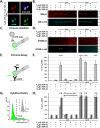Split GFP technologies to structurally characterize and quantify functional biomolecular interactions of FTD-related proteins
- PMID: 29070802
- PMCID: PMC5656600
- DOI: 10.1038/s41598-017-14459-w
Split GFP technologies to structurally characterize and quantify functional biomolecular interactions of FTD-related proteins
Abstract
Protein multimerization in physiological and pathological conditions constitutes an intrinsic trait of proteins related to neurodegeneration. Recent evidence shows that TDP-43, a RNA-binding protein associated with frontotemporal dementia and amyotrophic lateral sclerosis, exists in a physiological and functional nuclear oligomeric form, whose destabilization may represent a prerequisite for misfolding, toxicity and subsequent pathological deposition. Here we show the parallel implementation of two split GFP technologies, the GFP bimolecular and trimolecular fluorescence complementation (biFC and triFC) in the context of TDP-43 self-assembly. These techniques coupled to a variety of assays based on orthogonal readouts allowed us to define the structural determinants of TDP-43 oligomerization in a qualitative and quantitative manner. We highlight the versatility of the GFP biFC and triFC technologies for studying the localization and mechanisms of protein multimerization in the context of neurodegeneration.
Conflict of interest statement
The authors declare that they have no competing interests.
Figures





Similar articles
-
Split GFP complementation assay for quantitative measurement of tau aggregation in situ.Methods Mol Biol. 2011;670:109-23. doi: 10.1007/978-1-60761-744-0_9. Methods Mol Biol. 2011. PMID: 20967587
-
TDP-43 and FUS in amyotrophic lateral sclerosis and frontotemporal dementia.Lancet Neurol. 2010 Oct;9(10):995-1007. doi: 10.1016/S1474-4422(10)70195-2. Lancet Neurol. 2010. PMID: 20864052 Review.
-
Bimolecular fluorescence complementation; lighting-up tau-tau interaction in living cells.PLoS One. 2013 Dec 2;8(12):e81682. doi: 10.1371/journal.pone.0081682. eCollection 2013. PLoS One. 2013. PMID: 24312574 Free PMC article.
-
Development and implementation of split-GFP-based bimolecular fluorescence complementation (BiFC) assays in yeast.Biochem Soc Trans. 2008 Jun;36(Pt 3):479-82. doi: 10.1042/BST0360479. Biochem Soc Trans. 2008. PMID: 18481985
-
[Frontotemporal dementia (FTD) and genetic mutations including progranulin gene].Rinsho Shinkeigaku. 2008 Nov;48(11):990-3. doi: 10.5692/clinicalneurol.48.990. Rinsho Shinkeigaku. 2008. PMID: 19198141 Review. Japanese.
Cited by
-
Tau affects P53 function and cell fate during the DNA damage response.Commun Biol. 2020 May 19;3(1):245. doi: 10.1038/s42003-020-0975-4. Commun Biol. 2020. PMID: 32427887 Free PMC article.
-
Parkinson's disease motor symptoms rescue by CRISPRa-reprogramming astrocytes into GABAergic neurons.EMBO Mol Med. 2022 May 9;14(5):e14797. doi: 10.15252/emmm.202114797. Epub 2022 Apr 4. EMBO Mol Med. 2022. PMID: 35373464 Free PMC article.
-
Genetically Encoded Fluorescent Biosensors Illuminate the Spatiotemporal Regulation of Signaling Networks.Chem Rev. 2018 Dec 26;118(24):11707-11794. doi: 10.1021/acs.chemrev.8b00333. Epub 2018 Dec 14. Chem Rev. 2018. PMID: 30550275 Free PMC article. Review.
-
Design of a chromogenic substrate for elastase based on split GFP system-Proof of concept for colour switch sensors.Biotechnol Rep (Amst). 2019 Mar 18;22:e00324. doi: 10.1016/j.btre.2019.e00324. eCollection 2019 Jun. Biotechnol Rep (Amst). 2019. PMID: 31049301 Free PMC article.
-
Monomerization of TDP-43 is a key determinant for inducing TDP-43 pathology in amyotrophic lateral sclerosis.Sci Adv. 2023 Aug 4;9(31):eadf6895. doi: 10.1126/sciadv.adf6895. Epub 2023 Aug 4. Sci Adv. 2023. PMID: 37540751 Free PMC article.
References
Publication types
MeSH terms
Substances
LinkOut - more resources
Full Text Sources
Other Literature Sources

